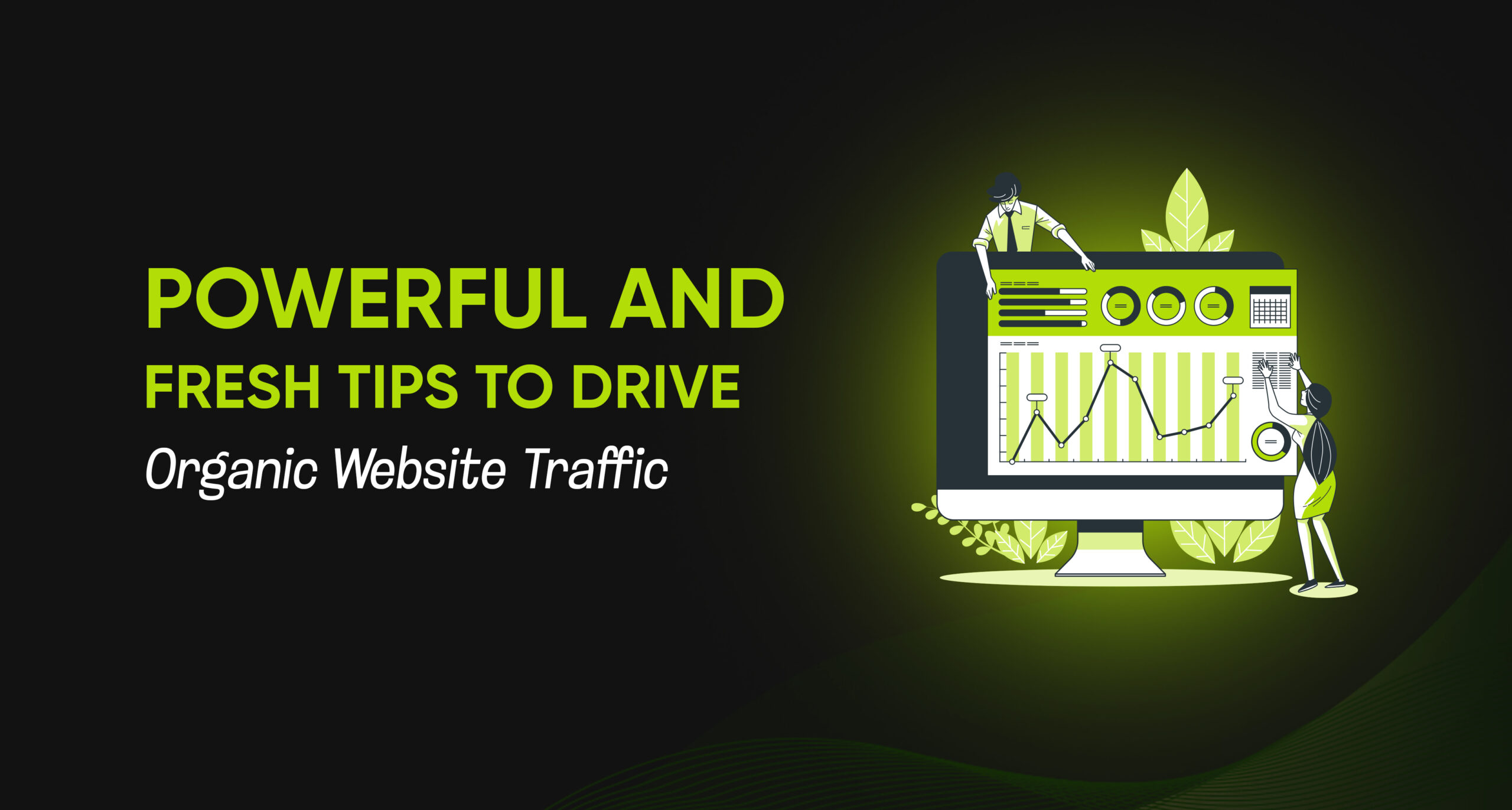Organic traffic is the lifeblood of any website looking to scale sustainably. Organic traffic is different from paid campaigns. You earn it by creating valuable content and using search engine optimization (SEO). You also need to understand what your audience is looking for.
A study shows that more than 50% of website traffic comes from organic search. This proves that investing in SEO is better than spending on short-term ads.
But in 2024, you must avoid stuffing keywords and publishing random blog posts to attract attention on Google. Search engines are smarter, user intent is sharper, and competition is tougher.
This guide offers more than just basic tips. It shares advanced and practical steps to boost organic traffic and build authority in your niche.
Understanding Organic Traffic (For the Sake of Clarity)

Before diving into tips, let’s clarify what organic traffic truly means. Organic traffic means users come to your website from a search engine like Google. These clicks incur no cost to you. Different from direct (typing your URL), referral (coming from another website), or paid traffic (via ads).
Because understanding the origin of your traffic helps tailor your strategies. Organic traffic shows that your content ranks well because of its quality, relevance, and SEO optimization. Google rewards this highly.
Google has changed how content ranks with its algorithm updates. These updates include Helpful Content and E-E-A-T, which stands for Experience, Expertise, Trustworthiness, and Trustworthiness. This means fluff pieces are no longer enough—you need genuinely helpful and well-structured content.
Why Organic Traffic is More Valuable Than Ever
Organic traffic doesn’t just fill up your analytics dashboard—it brings real, measurable value. A well-ranking blog post can continue to increase website visitors for months, even years, with minimal upkeep.
Second, organic visitors are more likely to trust your brand. Studies show users often skip ads and go straight to organic results because they perceive them as more credible.
Thirdly, it’s extremely budget-friendly. While PPC campaigns end the moment your budget runs out, SEO provides compounding returns. Many businesses choose to buy organic website traffic. They invest in content, SEO tools, and expert services.
At Imark Infotech, we design our SEO services to help businesses grow. We focus on building a strong foundation for long-term success through organic visibility.
Why Organic Wins:
- Higher ROI compared to paid ads
- Builds trust and credibility over time
- Offers compounding value from content and SEO investments
Foundational Pillars Before You Grow Traffic

Before you try to drive traffic to my site, it’s essential to fix what might be holding you back. Your website’s technical health, speed, and security directly affect both user experience and search rankings.
Must-Have Foundations:
- Mobile-Responsive Design: With over 60% of users browsing on mobile, a responsive layout is no longer optional.
- Page Speed: Use Google PageSpeed Insights to check performance. A slow site increases bounce rates and drops rankings.
- HTTPS Security: A secure website signals trust to users and search engines.
- Core Web Vitals: These metrics (LCP, FID, CLS) measure real-world UX. Google considers them for ranking.
Improving these basic aspects keeps visitors on your site longer. This will naturally increase your website traffic.
Let’s Build the Future Together
Unlock Customized Digital Solutions – Schedule a Free Strategy Session with Mselleo’s Experts Today!
SEO Basics You Must Master First
SEO isn’t about hacking Google; it’s about helping users find answers quickly and clearly. To bring traffic to your site, the fundamentals need to be solid.
Key SEO Must-Dos:
- Keyword Research: Use tools like Ubersuggest or Ahrefs to find keywords with decent volume and low competition.
- On-Page Optimization: Include target keywords naturally in titles, meta descriptions, headers, image alt tags, and internal links.
- Technical SEO: Set up your XML sitemap, optimize robots.txt, fix crawl errors, and implement canonical tags to avoid duplicate content issues.
- Schema Markup: Add structured data (FAQ, How-To, Article) to improve click-through rates.
Would you like a brief refresher on the fundamentals? Check out our blog on 10 SEO Do’s and Don’ts for Beginners to lay the groundwork for success.
High-Value, Content-Driven Strategies for More Traffic

Content is still important, but not just any content. The kind that ranks and helps increase web traffic is deep, focused, and user-centric. Aim for content hubs and clusters—interlinked articles around a central theme—to showcase topic authority.
Effective Content Strategies:
- Create Evergreen Content: How-to guides, listicles, and tutorials that stay relevant over time.
- Content Refreshing: Revisit old blogs to update stats, refine keywords, and republish.
- Answer Questions: Use tools like Answer The Public to see what your audience wants.
Content isn’t just about quantity—it’s about strategic alignment with your audience’s search journey. When individuals feel acknowledged and understood, they consistently return.
Strategic Content Formats That Google & Users Love
Not all content formats perform equally. Some make it easier for users and search engines to understand information quickly. This can boost website traffic by encouraging more clicks and shares.
Formats That Work:
- Listicles and How-Tos: Structured, scannable, and high-performing for search.
- Pillar Pages: In-depth guides on a topic that link out to supporting articles.
- Visual Content: Infographics and charts help illustrate data and keep users engaged.
- Video Integration: Embedding helpful videos increases time on site and reduces bounce rates.
Using different formats improves user experience. Google’s algorithm likes helpful and well-organized content. This can greatly boost organic traffic.
Get Discovered: Smart Keyword Targeting Beyond Google
While Google dominates search, savvy marketers know to optimize beyond it. Websites like YouTube, Reddit, and Pinterest act like small search engines. When utilized effectively, they can drive visitors to my website.
Non-Google Keyword Tactics:
- YouTube SEO: Use video titles, tags, and transcripts to rank content in both YouTube and Google.
- Pinterest Boards: Create visually appealing pins that link back to blog posts or landing pages.
- Reddit Participation: Offer value in niche subreddits and subtly link back to your content when relevant.
- Voice Search Optimization: Structure content with questions and concise answers to rank for voice queries.
Changing your content distribution means you are not relying on one algorithm. This approach also helps you find new ways to increase website visitors naturally.
You can check our guide on how SEO automation can help you. It shows how multi-channel optimization works well.
Backlink Strategies That Work in 2025

Backlinks remain one of Google’s top ranking factors. When trusted sites link to yours, it shows that your content is reliable and useful. This can help improve your website’s SEO and increase traffic naturally.
Backlinks differ in their worth. The days of link farms and mass submissions are over. In 2025, quality is more important than quantity.
Smart Link Building Techniques:
- Broken Link Building: Use tools like Ahrefs to find dead links on industry blogs, then pitch your relevant content as a replacement.
- Guest Posting: Contribute insightful posts to niche-specific websites with high domain authority.
- The Skyscraper Technique: Find top-performing content, create something better, and reach out to sites linking to the original.
- HARO (Help a Reporter Out): Provide expert insights to journalists for a chance to earn high-authority links.
To dive deeper into effective traffic-building methods, check out our guide on 15 ways to gain traffic fast.
Why Backlinks Matter:
- Builds domain authority
- Increases visibility in search results
- Helps boost website SEO in a sustainable, credible way
User Engagement Metrics You Can’t Ignore

Getting clicks is just the start. If users are not staying on your site, they may not engage with your content. This means your hard work may not pay off.
Google looks at metrics like bounce rate, session duration, and click-through rate. These are important signs of content quality and user satisfaction.
Key Metrics to Monitor:
- Bounce Rate: A high rate means users leave quickly, possibly because of poor UX or irrelevant content.
- Session Duration: More time on site suggests your content is engaging and informative.
- Pages Per Session: Encourages internal linking and content depth.
To improve web traffic through better engagement:
- Use clear CTAs to guide user flow.
- Break content into digestible sections.
- Add images and videos to keep users engaged.
Leverage tools like Google Analytics and Hotjar to analyze user behavior and refine your site for deeper interaction.
Leveraging Social Media to Amplify Organic Reach
Social media isn’t a direct ranking factor, but it plays a huge role in amplifying reach and visibility. A good social media plan can help you get more traffic to your website. It does this by showing your content to the right audience regularly and naturally.
Social boost Tips:
- Repurpose Content: Turn blog posts into carousel posts, quote graphics, and tweet threads.
- Engage Authentically: Respond to comments, join discussions, and share niche-relevant content beyond your own.
- Use hashtags and trends, especially on platforms like Twitter and LinkedIn, where keywords and activity drive Visibility.
Ensure you create links directing back to your landing pages. Create a content system that guides people from social media to your website. This will help you boost site traffic without paying for ads.
To learn how to get more visibility, check out our post. It covers how to repurpose content and engage on social media. You will find the best strategies to boost your website traffic.
Email Marketing as an Organic Growth Tool
One often overlooked but incredibly powerful method to drive traffic to a website consistently is email marketing. A well-kept email list makes sure you can reach an interested audience. This is true every time you share new content or launch a product.
Email Growth & Nurturing Tactics:
- Lead Magnets: Offer valuable downloads (like checklists, eBooks, templates) in exchange for email addresses.
- Content Updates: Notify subscribers about new blog posts, case studies, or SEO resources.
- Personalized Campaigns: Segment your audience by interest or behavior to send targeted messages.
Unlike social algorithms that fluctuate, email gives you complete control over who sees your content. Done right, it’s an excellent way to improve website traffic with minimal additional effort.
Local SEO Tips (If Applicable)

For businesses serving specific regions, Local SEO is essential. It allows you to increase website views from people searching for products or services in your area. Google often displays local pack results above organic listings, making it prime real estate.
Local Optimization Steps:
- Google Business Profile: Optimize your profile with keywords, images, reviews, and updated contact info.
- Citations: Ensure your NAP (Name, Address, Phone) is consistent across directories.
- Local Keywords: Target phrases like “best SEO agency in [city]” or “digital marketing service near me.”
Creating content for specific places can boost website traffic. This includes making service pages for different cities. It also involves writing blog posts that address local needs. This is because it captures local search intent.
Tools & Resources to Boost Organic Traffic
The right tools can streamline your strategy and help you make data-driven decisions that improve website hits. From keyword research to performance evaluation, having a reliable tech stack is a game-changer.
Top Tools for SEO & Traffic Growth:
- SEMrush / Ahrefs: For keyword tracking, backlink audits, and competitive evaluation.
- Surfer SEO / Frase: For content optimization based on SERP data.
- Google Search Console: To monitor search performance and fix crawl issues.
- Page Speed Insights & GTmetrix: To improve site speed and Core Web Vitals.
Each tool helps you track progress, find opportunities, and improve strategies to increase website traffic effectively.
Common Mistakes That effect Organic Traffic Potential
Sometimes, it’s not what you do, but what you overlook, that affects your ability to increase traffic on your website. Common SEO missteps can quietly erode your rankings, frustrate users, and waste content efforts.
What to Watch Out For:
- Keyword Stuffing: Overusing keywords makes content unreadable and Punishable.
- Thin Content: Pages with little value won’t rank and can drag down domain authority.
- Broken Links: These harm UX and reduce crawl efficiency.
- Poor internal linking can confuse users and bots without a proper content structure.
Check your content and technical health every three months. This will help you spot anything that might block your website traffic growth.
Let’s Build the Future Together
Join 1000s of Thriving Businesses – Partner with Mselleo for ROI-Driven SEO and Social Media Mastery!
Conclusion
However, with the right strategy and consistency, your hard work will pay off. Focus on the user, and your efforts will grow over time. Organic growth isn’t about chasing hacks; it’s about earning attention and trust.
“Keep in mind: SEO in 2025 will prioritize quality over shortcuts.” The more value you provide, the more Google and your users will reward you.
To speed up your efforts with expert help, consider working with Imark Infotech. They can help you create a strategy that fits your goals.



